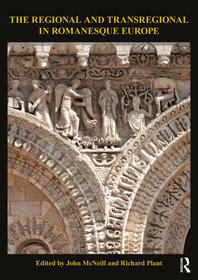
The Regional and Transregional in Romanesque Europe
Sorozatcím: The British Archaeological Association Romanesque Transactions;
-
20% KEDVEZMÉNY?
- A kedvezmény csak az 'Értesítés a kedvenc témákról' hírlevelünk címzettjeinek rendeléseire érvényes.
- Kiadói listaár GBP 38.99
-
18 627 Ft (17 740 Ft + 5% áfa)
Az ár azért becsült, mert a rendelés pillanatában nem lehet pontosan tudni, hogy a beérkezéskor milyen lesz a forint árfolyama az adott termék eredeti devizájához képest. Ha a forint romlana, kissé többet, ha javulna, kissé kevesebbet kell majd fizetnie.
- Kedvezmény(ek) 20% (cc. 3 725 Ft off)
- Kedvezményes ár 14 902 Ft (14 192 Ft + 5% áfa)
- A kedvezmény érvényes eddig: 2025. december 31.
Iratkozzon fel most és részesüljön kedvezőbb árainkból!
Feliratkozom
18 627 Ft

Beszerezhetőség
Becsült beszerzési idő: Várható beérkezés: 2026. január vége.
A Prosperónál jelenleg nincsen raktáron.
Why don't you give exact delivery time?
A beszerzés időigényét az eddigi tapasztalatokra alapozva adjuk meg. Azért becsült, mert a terméket külföldről hozzuk be, így a kiadó kiszolgálásának pillanatnyi gyorsaságától is függ. A megadottnál gyorsabb és lassabb szállítás is elképzelhető, de mindent megteszünk, hogy Ön a lehető leghamarabb jusson hozzá a termékhez.
A termék adatai:
- Kiadás sorszáma 1
- Kiadó Routledge
- Megjelenés dátuma 2021. november 30.
- ISBN 9780367752552
- Kötéstípus Puhakötés
- Terjedelem344 oldal
- Méret 297x210 mm
- Súly 1100 g
- Nyelv angol
- Illusztrációk 350 Illustrations, black & white; 39 Illustrations, color; 343 Halftones, black & white; 39 Halftones, color; 7 Line drawings, black & white; 7 Tables, black & white 266
Kategóriák
Rövid leírás:
The Regional and Transregional in Romanesque Europe considers the historiography and usefulness of regional categories, and in so doing explores the strength, durability, mutability and geographical scope of regional and transregional phenomena in the Romanesque period.
Több
Hosszú leírás:
The Regional and Transregional in Romanesque Europe considers the historiography and usefulness of regional categories and in so doing explores the strength, durability, mutability, and geographical scope of regional and transregional phenomena in the Romanesque period.
This book addresses the complex question of the significance of regions in the creation of Romanesque, particularly in relation to transregional and pan-European artistic styles and approaches. The categorization of Romanesque by region was a cornerstone of 19th- and 20th-century scholarship, albeit one vulnerable to the application of anachronistic concepts of regional identity. Individual chapters explore the generation and reception of forms, the conditions that give rise to the development of transregional styles and the agencies that cut across territorial boundaries. There are studies of regional styles in Aquitaine, Castile, Sicily, Hungary, and Scandinavia; workshops in Worms and the Welsh Marches; the transregional nature of liturgical furnishings; the cultural geography of the new monastic orders; metalworking in Hildesheim and the valley of the Meuse; and the links which connect Piemonte with Conques.
The Regional and Transregional in Romanesque Europe offers a new vision of regions in the creation of Romanesque relevant to archaeologists, art historians, and historians alike.
TöbbTartalomjegyzék:
1. The epistemological, political, and practical issues affecting regional categories in French Romanesque architecture 2. Hans Kubach’s treatment of regions in the study of Romanesque architecture 3. Did Zodiaque’s regional portrayal create a false impression as to the nature of Romanesque 4. Romanesque sculpture in Aquitaine: a history of the marginalisation of a widely imitated regional sculptural style 5. The baldachin-ciborium: the shifting meanings of a restricted liturgical furnishing in Romanesque art 6. Hildesheim as a nexus of metalwork production, c. 1130-1250 7. 'Mosan' metalwork and its diffusion in the Rhineland, France, and England 8. Winchester's Holy Sepulchre Chapel and Byzantium: iconographic transregionalism? 9. Transregional dynamics, monastic networks: Santa Fede in Cavagnolo, Conques, and the geography of Romanesque art 10. Tiron on the edge: cultural geography, regionalism and liminality 11. Four Romanesque Cistercian abbeys in Lesser Poland: the context of their foundation 12. The Cathedral of Catania and the creation of the Norman County of Sicily: transregional and transalpine models in the architecture of the late 11th century 13. ʻSchool’ or ʻmasons’ workshop’?: reflections on the so-called Wormser Bauschule and on the definition of regional style 14. Towards an anatomy of a regional workshop: the Herefordshire School revisited 15. Crossing the Pyrenees: migration, urbanization, and transregional collaboration in Romanesque Aragon 16. Transregionalism and particularity in Romanesque woodcarving in 12th-century Catalonia 17. Romanesque woodcarvers and plasterers in the Abruzzi: the Mediterranean connection 18. A country without regions?: the case of Hungary 19. Reassessing the problem of Scandinavian Romanesque 20. The creation of Castilian identity under Alfonso VIII and Leonor Plantagenet
Több

Alfred's Easy Ukulele Songs -- Standards & Jazz: 50 Classics from the Great American Songbook
6 679 Ft
6 145 Ft

autosalon. Nr. 64: Modelljahr 2018/2019, über 4000 Autos, alle Neuheiten
5 350 Ft
5 082 Ft









